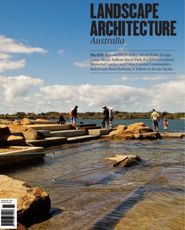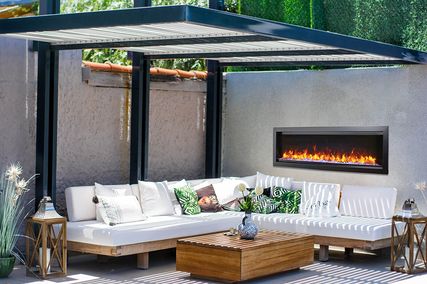
Kerb 19 – Paradigms of Nature: Post Natural Futures, edited by C. Daly, R. Ricardo, S. Hicks, A. Keene.
Kerb 19, edited by the RMIT University student team of Caitrin Daly, Sarah Hicks, Adrian Keene and Ricky Ricardo, begins with the proposition that “we are living in a post-evolutionary world of extreme technological escalation. The complexity of both natural and technical processes can now converge.” This statement reads as a call to arms for contemporary landscape practice: an opportunity to engage the convergence and, through the agency of speculative interrogation, defy the current trajectory of design by proposing scenarios of “considered inter-relationships with the natural world.”
This issue of the annual journal is divided into three curated chapters, each aligned with strategies suggested in the “Manifest-orial” for realization of the post-natural. Firstly, Neo-Natures accepts the implausibility of recovering a pristine version of nature, and instead investigates opportunities for technological interaction in real space. A conversation with Teresa Moller centres on recapturing the natural in design, bemoaning the artificiality of the artificial and emphasizing the importance of site specificity. The Super-Natural Garden imagines a tech-future linked to the natural, augmentations of existing form presenting visitors with the “presumed paradox of a human-designed nature,” while Daan Roosegaarde likens the post-natural movement to the artificial landscapes of the Netherlands, suggesting the post-natural future is about creating landscapes that “attract or generate stories within themselves.”
Chapter two, Beyond, explores the technology/nature contradiction in contemporary practice, challenging technology as a design process in itself and investigating design scenarios that respond primarily to site, but that also integrate natural and technological factors to produce complex, coexistent realities. This is manifest in an unsettling speculation on The Future, a radical community designed to generate greater symbiotic human-environment adaptation, complete with residents selected on their bio-abilities and potential for selective adaptation. Perhaps more comforting is Biothing’s exploration of urban tectonics, where mathematical systems and sub-systems provide an adaptive armature of polychromatic and phosphorescent organisms.
The final chapter, Synthesis, speculates upon a series of synthetic ecologies – post-natural designs integrating technologies with natural morphologies and cycles. Here, the foundations of Venice are strengthened with artificial reefs created by programmable protocells, while in the Sahara, biotechnical engineers edit the molecular structure of sand, using bacteria to create a calcified sandstone barrier, halting the migration of the desert. In each proposal, the post-natural appears as a reapplication of nature, to nature through technology, and less as a melding of the two in an imagined “technocology.”
It is the conversations with architectural firms R&Sie(n) and IwamotoScott, however, that offer the clearest insight into the duality of the post-natural narrative. François Roche and Stéphanie Lavaux of R&Sie(n) defer immediately to the view that the purpose of speculative work is to promote a reorganization of knowledge, describing not the reality of the present but rather alluding to potential futures provided in a parallel domain. While describing speculative exploration and transformation through the metaphor of a growing tree, they are careful to stress the importance of the incremental and the recursive. It is precisely the knowledge of what has come before – that is, evolution and regeneration as functions of that which already exists – that provides the opportunity for exploration of potentials in the alternative domain. Similarly, while IwamotoScott observes that parametric modelling offers rapid flexibility and iterative repetition for larger-scale projects, they maintain that the opportunity for seeding evolutionary or adaptive parametric processes rarely occurs, with the resultant urban projects instead sanitary and controlled. Advanced technologies and rapid reproduction suggest simulated scenarios, bereft of the evolutionary or iterative elements the process itself affords, and outcomes more pre-natural than post-natural – perhaps a function of parametric overload.
In many ways, it is acceptance of the project as an instrument of speculation that is at once the most interesting, yet most challenging, aspect of the post-natural treatise. Proposing new paradigms to recognize limitations in design practice is far from being a new concept. However, in suggesting the post-natural future as a vehicle to address the artefact/nature binary, the editors champion the recovery of contemporary landscape practice via re-engagement with the natural, be it through subversion, symbiosis, evolution, modification or otherwise. In doing so, they provide a clarity of focus that allows the reader to navigate an otherwise broad, tangential field and to skirt those questions of relevance and validity that might normally accompany discussion of a new paradigm. The emphasis remains on natural processes, with technology revealed as but a tool with which the essence of the natural is regained.
Kerb 19 succinctly traverses the proposition of converging technological and natural processes, filtering the structure and rigidity from an environment dominated by digital production and automated technologies, and revealing its ability for responsive adaptations. It aligns this cleverly with the initial call for spontaneous, speculative methodological approaches, challenging contemporary practice to locate itself on a trajectory “founded on acceptance of our role and place within the grander scheme of things.”
Editors C. Daly, R. Ricardo, S. Hicks, A. Keene, Melbourne Books, 2011, paperback, 128 pages. RRP $23.95.
Source

Discussion
Published online: 13 Jun 2012
Words:
Dan Young
Issue
Landscape Architecture Australia, February 2012














